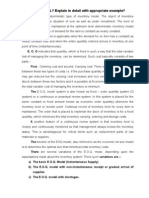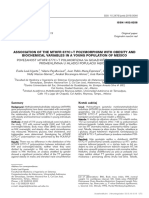Design and Performance Analysis of Genetic Based PID-PSS With SVC in A Multi-Machine System Considering Detailed Model
Design and Performance Analysis of Genetic Based PID-PSS With SVC in A Multi-Machine System Considering Detailed Model
Uploaded by
IDESCopyright:
Available Formats
Design and Performance Analysis of Genetic Based PID-PSS With SVC in A Multi-Machine System Considering Detailed Model
Design and Performance Analysis of Genetic Based PID-PSS With SVC in A Multi-Machine System Considering Detailed Model
Uploaded by
IDESOriginal Title
Copyright
Available Formats
Share this document
Did you find this document useful?
Is this content inappropriate?
Copyright:
Available Formats
Design and Performance Analysis of Genetic Based PID-PSS With SVC in A Multi-Machine System Considering Detailed Model
Design and Performance Analysis of Genetic Based PID-PSS With SVC in A Multi-Machine System Considering Detailed Model
Uploaded by
IDESCopyright:
Available Formats
2014 ACEEE
DOI: 01.IJEPE.5.1.6
ACEEE Int. J. on Electrical and Power Engineering , Vol. 5, No. 1, February 2014
Long Paper
Design and Performance Analysis of Genetic based
PID-PSS with SVC in a Multi-machine System
Considering Detailed Model
Hitesh Rameshchandra J ariwala
1
and Anandita Chowdhury
2
1
Electrical Engineering Department, S. V. National Institute of Technology, Surat, 395007, India.
Email: hrj@svnit.ac.in
2
Electrical Engineering Department, S. V. National Institute of Technology, Surat, 395007, India.
Email: ac@svnit.ac.in
Abstract Damping of power system oscillations with the help
of proposed optimal Proportional Integral Derivative Power
System Stabilizer (PID-PSS) and Static Var Compensator
(SVC)-based controllers are thoroughly investigated in this
paper. This study presents robust tuning of PID-PSS and
SVC-based controllers using Genetic Algorithms (GA) in
multi machine power systems by considering detailed model
of the generators (model 1.1). The effectiveness of FACTS-
based controllers in general and SVC-based controller in
particular depends upon their proper location. Modal
controllability and observability are used to locate SVCbased
controller. The performance of the proposed controllers is
compared with conventional lead-lag power system stabilizer
(CPSS) and demonstrated on 10 machines, 39 bus New England
test system. Simulation studies show that the proposed genetic
based PID-PSS with SVC based controller provides better
performance.
Index Terms Controllability, Genetic algorithms,
Observability, Power system modeling, Static VAr
compensators.
NOMENCLATURE
Generator rotor angle
Generator rotor speed
M Generator moment of Inertia
Angle of bus voltage
I Magnitude of line current
I
R
Shunt injected reactive current
V Magnitude of bus voltage
P
sh
Shunt injected real power
Q
sh
Shunt injected reactive power
B
sh
Shunt injected susceptance
I. INTRODUCTION
Damping of power system oscillations between
interconnected areas is very important for the reliable and
secured system operation. Such oscillations are of low
frequency (0.5 Hz -3 Hz) and occur when there is a fault in the
system or sudden change in load [1-2] or when existing
generation/load areas are connected to other similar areas
through relatively weak transmission lines.
With the increase in the demand it is very common that
power is transferred from one area to another through a tie
line. These oscillations may enforce limitations on power
transfer through tie line and/or may be responsible for loss of
synchronism. The damping of electromechanical oscillations
can be achieved by means of a proper control strategy. The
use of a supplementary control added to the Automatic Voltage
Regulator (AVR) is a practical and economic way to supply
additional damping to electromechanical oscillations and it is
achieved with the help of Power System Stabilizer (PSS).
The widely used conventional power system stabilizer
(CPSS), basically a lead-lag compensator, is designed using
the theory of phase compensation in the frequency domain
considering deviation of speed as control signal. It is
important to note that the parameters of the machine change
with loading. The dynamic behavior of the machine is quite
different with different operating conditions. A set of PSS
parameters which give good system performance under a
certain operating condition may not give equally good result
under different operating conditions. Sometimes CPSS may
cause great variation in the voltage profile and may even
result in leading power factor operation under severe
disturbances [3]. In order to improve the performance of CPSS,
quite good numbers of tuning techniques such as optimal
control, adaptive control, variable structure control etc. have
been proposed [4]. Apart from the techniques mentioned
above, methods based on artificial intelligence techniques
such as GA, simulated annealing, tabu search, fuzzy logic,
partical swam optimization etc. are also used for obtaining
parameters of CPSS [3-6].
Apart from PSSs, Flexible AC Transmission Systems
(FACTS) devices are also used to improve system stability.
Particularly, in multi-machine systems, use of CPSS may not
provide sufficient damping for inter-area oscillations. In such
cases, FACTS devices can provide effective damping [1-2],
[5-7]. Although, the damping duty of FACTS devices is not
their primary function, the capability of FACTS based
controller to increase electromechanical damping
characteristics has been recognized. The FACTS devices are
capable enough to control network conditions in a very fast
manner and this feature of FACTS can be exploited to improve
system stability [8]. FACTS devices such as Static VAr
Compensators (SVC), Static Synchronous Compensators
(STATCOM), Thyristor Control Series Compensators (TCSC)
and Unified Power Flow Controller (UPFC) have led their use
1
ACEEE Int. J. on Electrical and Power Engineering , Vol. 5, No. 1, February 2014
2014 ACEEE
DOI: 01.IJEPE.5.1.6
Long Paper
to damp inter-area oscillations [7-10].
Unlike PSS control at a generator location, the speed
deviations of the machines of interest are not readily available
to FACTS devices sited in the transmission path.
Furthermore, speed signals themselves may not be the best
choice for an input signal for FACTS devices. Because of
these reasons, it is desired to extract an input signal from the
locally measurable quantities at the controller location [11-
12]. An SVC is usually located at mid-point of a transmission
line or near the loads if voltage control is required. The location
is not so obvious when SVC is required for damping purpose.
Most of the studies suggest the midpoint of a transmission
line or load buses as the location for SVCs as the voltage
swings are maximum at these locations. Others however,
propose the generator bus bar for placing SVCs to damp
oscillations. In some studies, the location of SVC is found
using residue method. There obviously exists difference of
opinion for the best location of a SVC for damping of low
frequency oscillations.
Various techniques were applied to improve the
performance of the controllers. M. A. Abido et al. [7], [13-14]
have discussed the enhancement of stability by designing
PSS and SVC using real coded genetic algorithms considering
change in rotor speed as input for both controllers and Single
Machine Infinite Bus (SMIB) system was considered. Hu
Guo-qiang et al. [15] have used GA to design PSS for a four
machine system and verified its performance under different
operating conditions. Khodabakhshian et al. have [5] applied
same concept for a multi-machine system. Y. L. Abdel-Magid
et al. [16] applied TABU search method to tune parameters of
PSS for multi-machine system in which synchronous
machines are represented by model 1.0. Li-Jun Cai et al. [1]
applied Sequential Quadratic Programming (SQP) algorithm
for simultaneous tuning of PSS and FACTS damping
controllers in large power systems. X. Y. Bian et al. [17] have
employed probabilistic eigenvalue-based objective function
for design of PSS and SVC. Ahad Kazemi et al. [18 ] applied
fuzzy logic to tune parameters of PSS and FACTS based
controllers. A. Andreoiu et al. [19] have applied a Lyapunov
method based GA to tune the parameters of PSS and applied
it to SMIB system.
In most of the studies, change in rotor speed is
considered as input signal to SVC controller and generators
were represented by model 1.0. The objective of this study is
to present use of proposed PID-PSS controller and SVC based
controller for damping of power system oscillations with
locally available signals in multi-machine systems in which
all generators are represented by their detailed model (model
1.1). The optimal setting of parameters of both proposed PID-
PSS and SVC controller is obtained using Genetic algorithms.
The location of PID-PSS can be determined with the help of
Participation Factors [2]. However, in this study, it is
considered that all machines are equipped with proposed
PID-PSS.
To locate shunt FACTS devices like SVC, modal analysis
is carried out as discussed in the section II [11]. Modal
controllability and observability are determined for locally
available signals. Controllability of a signal depends on
location and nature of the FACTS device under consideration.
A higher controllability of a signal means smaller variable
compensation requirement of a controller.
The modal observability based ranking of candidate
locations can be more convenient than modal controllability
or residue based ranking as it can be done a priori on a system
without explicitly representing the FACTS damping controller
at each candidate location.
II. MODAL ANALYSIS OF POWER SYSTEMS
In order to identify the best location to site SVC and to
determine control signals for SVC based controller, linearized
analysis is carried out in which synchronous machine is
represented by its classical model. The controllability-
observability relationship for various locally available signals
is determined in this section.
A. Modal Analysis
For a multi-machine interconnected power system, the
complex non-linear model can be described in a set of
differential-algebraic equations by assembling the models
for each generator, load and other devices such as controls
in the system, and connecting them appropriately via the
network algebraic equations. These differential-algebraic
equations of a non-linear power system are given as,
Du X C Y
Bu X A X
+ A =
+ A = A
(1)
Classical techniques for the analysis and design of
controllers are mostly based on the linearized representation
of the power system at a representative operating point. While
carrying out linearized analysis of power system, following
assumptions are made:
1. Loads are considered as constant impedance type.
2. Synchronous machines are represented by classical
model.
3. Mechanical input to the generator is considered as
constant.
4. FACTS devices are considered as fast acting devices
as compared to the period associated with power
swings.
The linearized swing equations along with the real and
reactive power balance equations for all nodes and the lines
in which shunt and series compensation is present can be
represented as follows [2], [11].
(
(
(
(
(
(
(
(
A
A
A
A
=
A
A
A
A
V
J
R
I
sh
P
M
(2)
where, matrix J is represented as follows:
2
2014 ACEEE
DOI: 01.IJEPE.5.1.6
ACEEE Int. J. on Electrical and Power Engineering , Vol. 5, No. 1, February 2014
Long Paper
(
(
(
(
(
=
33 32
] 0 [
31
23 22
] 0 [
21
13 12
] 0 [
11
] 0 [ ] 0 [ ] 0 [
A A A
A A A
A A A
I
J
(3)
Here A
ij
are block matrices, M is a diagonal matrix and
following relationship holds true for the block matrices of J.
3 1 , =
=
j i
A A
T
ji ij
(4)
The elements of various sub-matrices shown in (3) are
the partial differentiations of (5) to (8) with respect to variables
mentioned in (2). For the k
th
generator, the swing equation
can be expressed as;
ek mk
k
k
P P
dt
d
M =
2
2
g
n k , 2 , 1 =
(5)
where, n
g
is number of generators in the system.
At any bus j (except generator internal bus), the injected
power P
shj
by a FACTS controller is given by;
( ) ( )
k j
m k dk
k j
i j
n i
ij
i j
Lj shj
j j
x
E V
x
V V
P P + + =
e e
sin sin
'
(6)
where, n
j
is set of buses connected to bus j by a transmission
line, m
j
is the set of generator (internal) buses connected to
bus j. P
Lj
is the power consumed by the load connected at
bus j, x
ij
is the reactance of the transmission line connecting
bus i and j and x
dk
is the transient reactance of generator k.
At the k
th
generator internal bus, injected power is given by,
( )
j k
dk
j k
ek
x
V E
P = sin
' (7)
The reactive current balance equation at the j
th
node is
given by:
( ) ( )
' '
cos cos
dk
k j j
m k dk
j
ij
i j i
n i
ij
j
shj j Rj
x
V
x
V
x
V
x
V
b V I
j j
+
+ =
e e
(8)
where, b
shj
is the fixed shunt susceptance at j
th
bus.
The controllable inputs of the system are:
| |
T
T
R
T
sh
I P u A A =
(9)
while observable quantities of the system are:
| |
T
T T
V y A A =
(10)
Equation (2) can be written in state space form as follows;
Bu A +
A
A
=
A
A
(
(11)
Du C y +
(
A
A
=
(12)
(
=
] 0 [
1
] 0 [
r
A M
I
A
(13)
| |
(
=
31
21
13 12 11
A
A
r
J A A A
r
A
(14)
r
J
A A
M B
(
=
13 12
] 0 [ ] 0 [
1
(15)
(
=
] 0 [
31
] 0 [
21
A
A
r
J C
(16)
D
A A
A A
r
J =
=
1
33 32
23 22
(17)
B. Modal Controllability and Observability
There is one eigenvector associated with each eigenvalue
of the state matrix A. For the i
th
eigenvalue
i
, the eigenvector
e
i
satisfies the equation.
(
= =
i
i
i i i
e
e
A Ae e
(18)
Each right eigenvector is a column vector with length
equal to number of states. The left eigenvector f
i
satisfies the
equation
| |A f f A f f
T
i
T
i
T
i i
T
i
= = (19)
For the system under consideration, it can be verified
that the right and left eigenvectors of state matrix A
corresponding to i
th
eigenvalue
i
have the following form:
(
=
(
=
i i
i
i
i
i
e
e
e
e
e
(20)
(
=
(
=
i
i i
i
i
i
f
f
f
f
f
(21)
Due to symmetry of the state matrix A and A
r
, the left and
right eigenvectors are related with each other as follows:
(
=
i
i i
i i
Me
Me
k f
(22)
Here, k
i
is a constant whose value can be chosen
arbitrarily.
The modal controllability and observability vectors are
defined by (23) and (24) respectively.
( )
i
T
T
T
i i
f B B f = =
(23)
i i
Ce = (24)
From (13) to (24), it can be shown that,
i i i
k = (25)
Above relation suggests that modal controllability and
observability vectors are parallel. This relation shows that
relative modal controllability using various inputs mentioned
in u can be inferred from the relative modal observability in
3
ACEEE Int. J. on Electrical and Power Engineering , Vol. 5, No. 1, February 2014
2014 ACEEE
DOI: 01.IJEPE.5.1.6
Long Paper
the output signals mentioned in y. Hence, the location of
series or shunt FACTS devices can be determined using
modal observability of the mode in the appropriate local
signals.
The structure and symmetry of the sub-matrices A
ij
unchanged if the inputs and corresponding outputs are
| |
T
T
sh
T
sh
Q P u A A =
'
(26)
T
o
T
T
V
V
y
(
A
A =
' (27)
or
| |
T
T
sh
T
sh
B P u A A =
"
(28)
| |
T
T
o
T
V V y A A =
"
(29)
Same results can be obtained for these set of inputs and
outputs. In this study, input-output pairs corresponding to
shunt FACTS devices are only considered. Here, V
o
is initial
operating voltage.
III. CONTROLLERS
The low frequency oscillations can be damped with the
help of controllers. In this study, a comparison is made on
the performance of CPSS, PID-PSS and SVC based controllers.
The structure of these controllers is as discussed below.
A. Conventional PSS
PSS introduces a component of additional damping
torque proportional to speed change through the excitation
system. The standard IEEE type-1 excitation system is as
shown in Fig.1(a). The structure of CPSS is illustrated in Fig
1(b). It consists of an amplification block, a wash out block
and a lead/lag block. The lead-lag blocks provide required
phase compensation. The input signal to the CPSS can be
change in speed, change in power or can be the combination
of both. In this study, change in speed of a machine is
considered as input to the CPSS.
(a)
(b)
Figure 1. (a) Excitation system (b) Conventional PSS
B. Proposed PID-PSS
Figure 2. Structure of PID-PSS with excitation system
The structure of PID-PSS along with excitation system is
as shown in Fig.2. The input to the PID-PSS controller is
change in rotor speed () of the machine on which it is
installed. The system can be described.
as.
( ) ( )
s t ref A
A
fd
V V V K
T dt
dE
+ =
1
(30)
where, K
A
and T
A
are the gain and time constant of the excitation
system respectively; V
ref
is the reference voltage; K
P
, K
I
and
K
D
are the Proportional, Integral and Derivative gain for the
machine on which it is installed. The supplementary stabilizing
signal V
s
is generated with the help of PID-PSS installed in
the feedback loop is as shown in Fig. 2.
C. SVC Based Controller
Figure 3 represents the block diagram of a SVC with lead-
lag compensator [3]. The susceptance B of an SVC can be
expressed as:
( ) ( )
sh svc ref s
s
sh
B u B K
T dt
dB
=
1
(31)
where, B
ref
is the reference susceptance of SVC, K
s
and T
s
are
gain and time constant of SVC respectively.
The parameters of CPSS are obtained using phase
compensation techniques and those of PID-PSS and SVC
based controller are obtained with the help of GA, which is
discussed in next section.
Figure 3. SVC based controller
IV. OBJECTIVE FUNCTION AND GA
GA have recently found extensive applications in solving
global optimization searching problems. They are useful when
4
2014 ACEEE
DOI: 01.IJEPE.5.1.6
ACEEE Int. J. on Electrical and Power Engineering , Vol. 5, No. 1, February 2014
Long Paper
the closed form optimization technique cannot be applied.
GA simultaneously evaluates many points in the parameter
space, so it is more likely to converge towards global minimum
solution.
GA is used to search for optimal PID controller parameters.
GA are powerful search algorithms based on the mechanics
of natural selection and natural genetics.
- These algorithms work with a population of strings,
searching many peaks in parallel, as opposed to a
single point.
- GA work directly on strings of characters
representing the parameter set, not the parameter
themselves.
- GA use probabilistic transition rules instead of
deterministic rules.
- GA use objective function information instead of
derivatives or other auxiliary knowledge.
To determine the optimal controller settings, GA method
is applied. GA optimal technique is used to minimize
performance index which is of Integral Square Error (ISE)
type.
Objective function considered is,
Minimize
dt t e J
e
) (
0
2
}
=
(32)
To get the optimal setting of K
P
, K
I
and K
D
, the error
function is minimized.
Figure 4. Transfer function
Here, e(t) is the error signal generated by taking a
difference between reference input and the feedback signal
as shown in Fig 4. In this study, speed deviation () of
individual machine is considered as error function while
designing proposed PID-PSS.
V. SIMULATION RESULTS
To validate the discussion done in previous sections,
simulation is carried out on the 10 machine, 39 bus system as
shown in Fig.5. The system data and the load flow data are
taken from [20]. The generators are represented by a classical
model and loads are modeled as constant impedance. This
system has nine oscillatory modes with eigenvalues as shown
in Table I.
The magnitude of controllability and observability are
obtained by considering shunt susceptance B
sh
as an input
and bus voltage V as an output of the system for the swing
mode ( = 0.0004896 4.2432i) having frequency 0.6756 Hz.
These values are mentioned in Table II which shows that the
ratio of controllability to observability is constant for the
input-output pair mentioned above. These results suggest
that modal controllability and modal observability vectors
are parallel. The normalized values of above quantities show
that susceptance of bus no. 4 has the highest controllability.
The voltage of same bus number has the highest
observability. So, the observability vector alone can be used
to locate shunt FACTS device like SVC.
Figure 5. 10 machines, 39 bus test system
TABLE I. OSCILLATORY MODES - CLASSICAL MODEL
Sr. no. Eigenvalues corresponding to oscillatory modes
1 0.0005898 9.4268i
2 0.0004152 9.7135i
3 0.0004109 9.7847i
4 0.0005942 8.1050i
5 0.0007225 7.7813i
6 0.0001917 7.6271i
7 0.0002408 6.8163i
8 0.0004412 6.2298i
9 0.0004896 4.2432i
The values of controllability and observability consider-
ing B
sh
as an input and bus voltage V as an output of the
system are also obtained considering detailed model of the
generators (model 1.1). In this case also the loads are mod-
eled as constant impedance. There are nine swing modes for
the system under consideration and the eigenvalues corre-
sponding to these modes are as listed in Table III (eigenval-
ues without controllers). The real parts of these eigenvalues
suggest that the damping is very poor and system may be-
come unstable if a disturbance is applied as two of the eigen-
values have positive real part. The magnitudes of controlla-
bility and observability are shown in Table IV for a swing
mode (l = -0.085428 4.3617i) having frequency of 0.6943 Hz
and damping ratio of 0.0196. In this case the ratio of control-
lability to observability does not remain constant but remains
in a narrow range. A closer scrutiny of Table II and Table IV
show that ranking of locations by observability vector for
the classical and detailed model matches closely. The bus
with highest controllability and highest observability is the
same and it agrees with the result obtained with classical
model of the generators. Hence, observability vector alone
can be used to screen out locations with poor controllability.
5
ACEEE Int. J. on Electrical and Power Engineering , Vol. 5, No. 1, February 2014
2014 ACEEE
DOI: 01.IJEPE.5.1.6
Long Paper
TABLE II. CONTROLLABILI TY AND OBSERVABI LITY-CLASSICAL MODEL
= -0.085428 4.3617i
Bus
no.
max
max
1 2.6662 0.005263 506.56 0.50381 0.50381
2 2.0464 0.00404 506.54 0.38669 0.38671
3 3.1599 0.006238 506.56 0.59712 0.59712
4 5.292 0.010447 506.56 1 1
5 5.0363 0.009942 506.56 0.95168 0.95168
6 5.0392 0.009948 506.56 0.95223 0.95222
7 5.2187 0.010302 506.57 0.98615 0.98614
8 3.0389 0.005999 506.56 0.57424 0.57424
9 4.8879 0.009649 506.57 0.92365 0.92362
10 2.6766 0.005284 506.55 0.50579 0.5058
11 0.37291 0.000736 506.52 0.070466 0.070472
12 2.4218 0.004781 506.55 0.45763 0.45764
13 2.7303 0.00539 506.54 0.51593 0.51596
14 2.5239 0.004983 506.53 0.47694 0.47696
15 2.2057 0.004355 506.54 0.41681 0.41683
16 2.2466 0.004435 506.54 0.42452 0.42454
17 1.9057 0.003762 506.53 0.3601 0.36012
18 1.7505 0.003456 506.53 0.33078 0.3308
19 0.56084 0.001107 506.54 0.10598 0.10598
20 2.6755 0.005282 506.55 0.50557 0.50558
21 4.2277 0.008346 506.55 0.79889 0.79891
22 4.6403 0.009161 506.56 0.87686 0.87687
23 4.6413 0.009163 506.56 0.87705 0.87705
24 3.9509 0.0078 506.54 0.74658 0.7466
25 2.7169 0.005364 506.55 0.51339 0.5134
26 3.4477 0.006806 506.54 0.65149 0.65151
27 3.4311 0.006774 506.54 0.64835 0.64838
28 4.0542 0.008004 506.55 0.76611 0.76612
29 4.3129 0.008514 506.56 0.81499 0.81498
30 4.8738 0.009622 506.55 0.92098 0.92099
31 2.5331 0.005001 506.54 0.47867 0.47868
32 2.6192 0.005171 506.54 0.49494 0.49495
33 2.7104 0.005351 506.54 0.51216 0.51218
34 2.8122 0.005552 506.54 0.53142 0.53144
35 3.5124 0.006934 506.54 0.66372 0.66375
36 3.8622 0.007625 506.54 0.72981 0.72984
37 3.4934 0.006897 506.54 0.66014 0.66016
38 3.1883 0.006294 506.54 0.60248 0.6025
39 4.6738 0.009227 506.55 0.88319 0.8832
TABLE III. OSCILLATORY MODES WITHOUT AND WITH CONTROLLERS-DETAILED
MODEL
Sr.
no.
Eigen values without
controllers
Eigen values with controllers
1 -0.04820 10.3350i -0.2892 9.2470i
2 -0.17342 10.2740i -0.3087 9.7690i
3 0.09861 9.9508i -0.2767 9.1052i
4 -0.25513 8.8299i -0.7190 8.3784i
5 - 0.29057 7.6048i -0.7806 7.4287i
6 -0.38441 8.1870i -1.2647 7.9450i
7 0.07293 7.5473i -0.2432 7.4274i
8 -0.005868.3051i -0.2365 8.1529i
9 -0.08542 4.3617i -0.3642 4.1705i
TABLE IV. CONTROLLABILI TY AND OBSERVABILI TY-DETAILED MODEL
= -0.085428 4.3617i
Bus
no.
max
max
1 0.46134 0.038352 12.029 0.51711 0.5255
2 0.30674 0.025051 12.244 0.34381 0.34326
3 0.52266 0.04355 12.001 0.58584 0.59672
4 0.89216 0.072982 12.224 1 1
5 0.84201 0.069044 12.195 0.94379 0.94604
6 0.84818 0.068945 12.302 0.95071 0.94469
7 0.86773 0.0707 12.273 0.97262 0.96874
8 0.51707 0.042497 12.167 0.57957 0.5823
9 0.72616 0.060394 12.024 0.81394 0.82752
10 0.48531 0.039818 12.188 0.54397 0.54559
11 0.04693 0.003975 11.808 0.052609 0.054465
12 0.4427 0.036444 12.148 0.49621 0.49935
13 0.49356 0.041727 11.828 0.55322 0.57174
14 0.46066 0.039276 11.729 0.51634 0.53817
15 0.40939 0.034459 11.88 0.45887 0.47216
16 0.41587 0.034794 11.952 0.46613 0.47675
17 0.36049 0.03079 11.708 0.40406 0.42188
18 0.33449 0.028768 11.627 0.37492 0.39418
19 0.07020 0.005251 13.371 0.07869 0.071944
20 0.48174 0.039751 12.119 0.53997 0.54467
21 0.74473 0.061158 12.177 0.83475 0.838
22 0.80583 0.065218 12.356 0.90323 0.89362
23 0.80633 0.065368 12.335 0.90379 0.89567
24 0.69747 0.058152 11.994 0.78177 0.7968
25 0.48684 0.039964 12.182 0.54569 0.54759
26 0.59805 0.049684 12.037 0.67034 0.68078
27 0.60078 0.050714 11.846 0.6734 0.69488
28 0.6747 0.055217 12.219 0.75626 0.75659
29 0.69933 0.05695 12.28 0.78386 0.78034
30 0.85037 0.069054 12.315 0.95316 0.94618
31 0.46035 0.038129 12.074 0.51599 0.52244
32 0.47464 0.039325 12.07 0.53202 0.53883
33 0.4892 0.04052 12.073 0.54833 0.55521
34 0.50811 0.042596 11.929 0.56953 0.58365
35 0.62359 0.052608 11.853 0.69897 0.72084
36 0.68261 0.056884 12 0.76512 0.77943
37 0.61813 0.051943 11.9 0.69285 0.71173
38 0.56775 0.048025 11.822 0.63637 0.65805
39 0.81197 0.065928 12.316 0.91012 0.90334
VI. DESIGN OF CONTROLLERS
A. Design of PID-PSS
To determine the parameters of PID-PSS of each machine,
the optimization problem is formulated as below:
Minimize J
e
Subject to
max min
max min
max min
D D D
I I I
P P P
K K K
K K K
K K K
s s
s s
s s
(33)
where J
e
is the objective function mentioned in (32).
The parameters of PID-PSS are obtained by following an
algorithm as shown in Fig. 6. To set the optimal values of
parameters of proposed PID-PSS, GA has been applied with
moderate population size of 20, number of generation 20,
small mutation probability of 0.002 and relatively high cross
over probability 0.8.
The convergence graph of performance index for
generator 5 is shown in Fig 7. It shows that PI decreases with
increase in number of generations and it is converging after
10 generations. Similarly the parameters of other PID-PSS
installed on respective machine are obtained. The final
settings of the optimized parameters for the proposed
stabilizer are given in Table V.
6
2014 ACEEE
DOI: 01.IJEPE.5.1.6
ACEEE Int. J. on Electrical and Power Engineering , Vol. 5, No. 1, February 2014
Long Paper
Figure 6. Flow chart to design PID-PSS based on GA
Figure 7. Convergence graph of performance index for PI D-PSS
TABLE V. OPTIMAL PARAMETERS OF PID-PSS
Generator KP KI KD
1 93.3058 88.949 1.3914
2 98.5082 94.9153 0.0457
3 81.1264 80.0 4.2767
4 82.8837 83.678 1.408
5 80.2594 88.6323 1.3914
6 80.2594 89.8823 1.0202
7 82.9365 80.457 5.8136
8 80.7004 86.8653 5.4705
9 80.7003 82.4903 1.408
10 86.6681 91.3689 1.1093
B. Design of SVC Based Controller
The parameters of the SVC based controller are obtained
by solving following optimization problem using GA. In this
controller, T
w
, T
2
and T
4
are usually pre-specified [3].
Minimize J
e
Subject to
max
3 3
min
3
max
1 1
min
1
max min
T T T
T T T
K K K
s s
s s
s s
(34)
Figure 8. Convergence graph of performance index for SVC
To set the optimal values of parameters of SVC, GA has
been applied with moderate population size of 50, number of
generation 20, small mutation probability of 0.005 and
relatively high cross over probability 0.4. The convergence
graph of performance index (PI) is shown in Fig. 8. In this
case also PI decreases with increase in number of generations
and it is converging after 16 generations. The optimum
parameters of SVC based controller are obtained by following
the algorithm mentioned in Fig. 6 in which K
P
, K
I
and K
D
are
replaced by K, T
1
and T
3
respectively and they are mentioned
in Table VI.
TABLE VI. OPTI MAL PARAMETERS OF SVC BASED CONTROLLER
K T1 T2 T3 T4
3 0.2248 0.1945 0.2323 0.3484
The location of the SVC based controller is determined
by studying modal controllability and observability of the
susceptance signal B
sh
and bus voltage V respectively. The
values of controllability and observability mentioned in Table
IV suggest that bus no. 4 is the best location for SVC to damp
power system oscillations. The voltage of bus no. 4 is
considered as the control signal for the controller. To compare
the performance of proposed PID-PSS and SVC based
controllers, CPSSs are also designed for each machine. The
parameters of the CPSS are obtained by using phase
compensation techniques and they are listed in Table VII.
To verify the performance of the controllers, a 200 ms
three phase fault (10 cycles) is created on bus no. 14 of the
test system. In order to observe full transient behavior of the
system, sufficiently large simulation time is considered. The
variation of rotor angle of generator 1 and generator 3 are
shown in Fig. 9 and Fig. 10, respectively for aforesaid fault.
The performance is also verified by increasing the fault
duration to 300 ms (15 cycles) at the same location. The varia-
tion of rotor angle of generator 1 and generator 3 are shown
in Fig. 11 and Fig. 12, respectively for this fault duration. It is
found that settling time for the responses considering CPSS
is about 20 s. It is improved to about 10 s when machines are
equipped with proposed PID-PSS. The settling time is less
7
ACEEE Int. J. on Electrical and Power Engineering , Vol. 5, No. 1, February 2014
2014 ACEEE
DOI: 01.IJEPE.5.1.6
Long Paper
than 10 s when proposed PID-PSSs act along with SVC. The
peak deviations are also reduced when proposed PID-PSSs
act along with SVC.
TABLE VII. PARAMETERS OF CPSS
Generator TW K T1 T2 T3 T4
1 10 8 0.1699 0.0122 0.0932 0.1695
2 10 9 0.52 0.004 0.0875 0.1179
3 10 9 0.487 0.0038 - -
4 10 7 0.512 0.0034 0.2477 0.0826
5 10 7 0.512 0.0034 0.2477 0.0826
6 10 8 0.52 0.004 - -
7 10 2 0.03977 0.5195 0.03977 0.5195
8 10 2 0.03977 0.5195 0.03977 0.5195
9 10 7 0.512 0.0034 0.2477 0.0826
10 10 7 0.512 0.0034 0.2477 0.0826
Figure 9. Rotor angle of generator-1 for a fault on bus no.14 for
0.2s
Figure 10. Rotor angle of generator -3 for a fault on bus no.14 for
0.2s
To check robustness of the controllers, a step change of
0.2 pu is applied to mechanical power input to generator 1.
The oscillations in rotor angle of generator 1 due to this
change are shown in Fig.13. In this case overshoots are al-
most vanished when PID-PSSs are used. In this case also the
result is further improved when proposed PID-PSS and SVC
controllers act together and generator reaches to its new an-
gular position quickly as compared to CPSS. Similar results
can be obtained for other generators and any other fault loca-
tion.
The eigenvalues corresponding to swing modes are
Figure 11. Rotor angle of generator-1 for a fault on bus no.14 for
0.3s
Figure 12. Rotor angle of generator -3 for a fault on bus no.14 for
0.3 s
mentioned in Table III without controllers and with proposed
PID-PSSs and SVC based controller. The eigenvalues
corresponding to swing modes with controllers are as shown
in Table III (eigenvalues with controllers). The improvement
in the real part of eigenvalues is the indication of the good
performance of the controllers.
Figure 13. Rotor angle of generator-1 for a change of 0.3 pu in
mechanical input of generator 1
VII. CONCLUSIONS
The power system stability enhancement with the help of
proposed PID-PSS and SVC-based controllers is presented
and discussed. The GA optimal technique was used to find
optimal setting of PID-PSS and SVC-based stabilizers. Modal
8
2014 ACEEE
DOI: 01.IJEPE.5.1.6
ACEEE Int. J. on Electrical and Power Engineering , Vol. 5, No. 1, February 2014
Long Paper
controllability vector and observability vectors are parallel
for certain input-output pairs when generators are represented
by classical model. Hence, modal observability vector can be
used to locate FACTS devices. The ratio of these vectors is
not constant when detailed model (model-1.1) of the generator
is considered. However, the ratio remains within the narrow
range for certain input-output pairs as mentioned and ranking
based on classical model and detailed model match closely.
Hence, the modal observability can be used to screen out
locations with poor controllability.
The location of SVC and its control signal are determined
by modal analysis. The proposed GA based stabilizers were
tested on a multi-machine power system by applying various
disturbances. The simulation results show the robustness
and effectiveness of the suggested stabilizers to enhance
the system stability. The results are also compared with
conventional lag-lead type PSS with change in speed as an
input to stabilizer. The simulation results show that the
proposed PID-PSSs give better results than conventional
PSSs. The use of SVC-based stabilizer improves the
performance of the system further.
REFERENCES
[1] Li-J un Cai, Istvan Erlich, Simultaneous coordinated tuning
of PSS and FACTS damping controllers in large power
systems, IEEE Trans. on Power Systems, vol.20, No.1, pp.
294-299 February 2005.
[2] Magdy E. Aboul-Ela, A. A. Sallam, J ames D. McCalley, A. A.
Fouad, Damping controller design for power system
oscillations using global signals , IEEE Trans. on Power
Systems, vol.11, No.2, pp. 767-773, May 1996.
[3] Pouyan Pourbeik, Michael J . Gibbard, Simultaneous
coordination pf power system stabilizers and FACTS devices
stabilizers in a multimachine power system for enhancing
dynamic performance, IEEE Trans on Power Systems, vol.
13, No.2, pp.473-478, May 1998.
[4] Ning Yang, Qinghua, J ames D. McCalley, TCSC controller
design for damping inter area oscillations, IEEE Trans on
Power Systems, vol.13, No 4, pp1304-1310, November 1998.
[5] A. Khodabakhian, R. Hooshmand, R. Sharifian, Power system
stability enhancement by designing PSS and SVC parameters
coordinately using RCGA, Canadian Conf. on Electrical and
Computer Engineering, pp.579-582, 2009.
[6] Nadarajah Mithulananthan, Claudio A. Canizares, J ohn Reeve,
Graham J . Rogers, Comparison of PSS, SVC and STATCOM
controllers for damping power system oscillations, IEEE
Trans. on Power Systems, vol.18, no.2, pp1-6, May 2003.
[7] M. A. Abido, Y. L. Abdel-Magid, Power system stability
enhancement via coordinated designs of a PSS and an SVC
based controller, 10th IEEE conf. on Electronics, Circuits
and Systems, pp. 850-853, 2003.
[8] Y. L. Abdel-Majid, M. A. Abido, S. Al-Baiyat, A. H. Mantawy,
Simultaneous stabilization of multi-machine power systems
via genetic algorithms, IEEE Trans. PWRS, Vol. 14, No. 4,
pp.1428-1439, 1999.
[9] Y. L. Abdel-Majid, M. A. Abido, Optimal multi-objective
design of robust power system stabilizers using genetic
algorithms, IEEE Tran. on Power systems, vol. 18, No. 3,
pp. 1125-1132, August 2003.
[10] A. Beik Khormizi, A. Salem Nia, Damping of power system
oscillations in multi-machine power systems using coordinate
design of PSS and TCSC, 10th international conference on
Environment and Electrical Engg., pp.1-4, 2011.
[11] U. P. Mhaskar, A. M. Kulkarni, Power oscillation damping
using FACTS devices: Modal controllability. Observability in
local signals and location of transfer function zeros, IEEE
Trans. on Power Systems, vol. 21, No.1, pp. 285-294
February 2006.
[12] Suman Bhowmick, A comparison of commonly used signals
for power oscillations damping, 1st IEEE Indian annual
conference, pp.456-459, 2004.
[13] M. A. Abido, Design of PSS and STATCOM based damping
stabilizers using genetic algorithms, IEEE Power Engineering
Society General Meeting, pp.1-8, 2006.
[14] M. A. Abido, Y. L. Abdel-Magid, Coordinated design of a
PSS and an SVC based controller to enhance power system
stability, Elsevier journal on Elect. Power and Energy Sys.,
vol. 25, pp. 695-704, 2003.
[15] H. Guo-qiang, X. Dong-jie, H. Ren-mu, Genetic algorithms
based design of power system stabilizers, IEEE conf. on
Electric utility, Deregulation, Restructuring and Power Tech.,
167-171, April 2004.
[16] Y. L. Abdel-Magid, M. A. Abido, A. H. Mantawy, Robust
tuning of power system stabilizers in multi-machine power
systems, IEEE Trans. on Power Systems, vol.15, No.2, pp
735-740 May 2000.
[17] X. Y. Bian, C. T. Tse, J .F. Zhang, K. W. Wang, Coordinated
design of probabilistic PSS and SVC damping controllers,
Elsevier journal on Electrical Power and Energy Systems, vol.
33, pp. 445-452, 2011.
[18] Ahad Kazemi, Mahmoud Vakili Sohrforouzani, Power system
damping using fuzzy controlled facts devices, Elsevier journal
on Electrical Power and Energy Systems, vol. 28, pp. 349-
357, 2006.
[19] A. Andreoiu, K. Bhattacharya, Robust tuning of power
system stabilizers using a Lyapunov method based genetic
algorithms, IEE Proceedings on Generation, Transmission
and Distribution, vol.149,No.5, pp.585-592, September 2002.
[20] A. K. Behra, Transient stability analysis of multi-machine
power systems using detailed machine models, Ph. D Thesis,
University of Illinois, Urbana-Champaign, 1988.
9
You might also like
- The Subtle Art of Not Giving a F*ck: A Counterintuitive Approach to Living a Good LifeFrom EverandThe Subtle Art of Not Giving a F*ck: A Counterintuitive Approach to Living a Good LifeRating: 4 out of 5 stars4/5 (5947)
- The Gifts of Imperfection: Let Go of Who You Think You're Supposed to Be and Embrace Who You AreFrom EverandThe Gifts of Imperfection: Let Go of Who You Think You're Supposed to Be and Embrace Who You AreRating: 4 out of 5 stars4/5 (1109)
- Hidden Figures: The American Dream and the Untold Story of the Black Women Mathematicians Who Helped Win the Space RaceFrom EverandHidden Figures: The American Dream and the Untold Story of the Black Women Mathematicians Who Helped Win the Space RaceRating: 4 out of 5 stars4/5 (927)
- Grit: The Power of Passion and PerseveranceFrom EverandGrit: The Power of Passion and PerseveranceRating: 4 out of 5 stars4/5 (618)
- Shoe Dog: A Memoir by the Creator of NikeFrom EverandShoe Dog: A Memoir by the Creator of NikeRating: 4.5 out of 5 stars4.5/5 (545)
- The Hard Thing About Hard Things: Building a Business When There Are No Easy AnswersFrom EverandThe Hard Thing About Hard Things: Building a Business When There Are No Easy AnswersRating: 4.5 out of 5 stars4.5/5 (354)
- Elon Musk: Tesla, SpaceX, and the Quest for a Fantastic FutureFrom EverandElon Musk: Tesla, SpaceX, and the Quest for a Fantastic FutureRating: 4.5 out of 5 stars4.5/5 (476)
- The Little Book of Hygge: Danish Secrets to Happy LivingFrom EverandThe Little Book of Hygge: Danish Secrets to Happy LivingRating: 3.5 out of 5 stars3.5/5 (419)
- Devil in the Grove: Thurgood Marshall, the Groveland Boys, and the Dawn of a New AmericaFrom EverandDevil in the Grove: Thurgood Marshall, the Groveland Boys, and the Dawn of a New AmericaRating: 4.5 out of 5 stars4.5/5 (270)
- The Sympathizer: A Novel (Pulitzer Prize for Fiction)From EverandThe Sympathizer: A Novel (Pulitzer Prize for Fiction)Rating: 4.5 out of 5 stars4.5/5 (123)
- Team of Rivals: The Political Genius of Abraham LincolnFrom EverandTeam of Rivals: The Political Genius of Abraham LincolnRating: 4.5 out of 5 stars4.5/5 (235)
- A Heartbreaking Work Of Staggering Genius: A Memoir Based on a True StoryFrom EverandA Heartbreaking Work Of Staggering Genius: A Memoir Based on a True StoryRating: 3.5 out of 5 stars3.5/5 (232)
- On Fire: The (Burning) Case for a Green New DealFrom EverandOn Fire: The (Burning) Case for a Green New DealRating: 4 out of 5 stars4/5 (75)
- Project Report Heimalya HerbalDocument78 pagesProject Report Heimalya Herbalkeshu75% (4)
- The Unwinding: An Inner History of the New AmericaFrom EverandThe Unwinding: An Inner History of the New AmericaRating: 4 out of 5 stars4/5 (45)
- Optimal Placement of DG For Loss Reduction and Voltage Sag Mitigation in Radial Distribution Systems Using ABC AlgorithmDocument6 pagesOptimal Placement of DG For Loss Reduction and Voltage Sag Mitigation in Radial Distribution Systems Using ABC AlgorithmIDESNo ratings yet
- Study of Structural Behaviour of Gravity Dam With Various Features of Gallery by FEMDocument8 pagesStudy of Structural Behaviour of Gravity Dam With Various Features of Gallery by FEMIDESNo ratings yet
- 1010Document6 pages1010Wil LamNo ratings yet
- Rotman Lens Performance AnalysisDocument6 pagesRotman Lens Performance AnalysisIDESNo ratings yet
- Various OSI Layer Attacks and Countermeasure To Enhance The Performance of WSNs During Wormhole AttackDocument6 pagesVarious OSI Layer Attacks and Countermeasure To Enhance The Performance of WSNs During Wormhole AttackIDESNo ratings yet
- Shot Boundary Detection Using Radon Projection MethodDocument5 pagesShot Boundary Detection Using Radon Projection MethodIDESNo ratings yet
- Never Split the Difference: Negotiating As If Your Life Depended On ItFrom EverandNever Split the Difference: Negotiating As If Your Life Depended On ItRating: 4.5 out of 5 stars4.5/5 (888)
- The Yellow House: A Memoir (2019 National Book Award Winner)From EverandThe Yellow House: A Memoir (2019 National Book Award Winner)Rating: 4 out of 5 stars4/5 (99)
- The Emperor of All Maladies: A Biography of CancerFrom EverandThe Emperor of All Maladies: A Biography of CancerRating: 4.5 out of 5 stars4.5/5 (274)
- The World Is Flat 3.0: A Brief History of the Twenty-first CenturyFrom EverandThe World Is Flat 3.0: A Brief History of the Twenty-first CenturyRating: 3.5 out of 5 stars3.5/5 (2272)
- Her Body and Other Parties: StoriesFrom EverandHer Body and Other Parties: StoriesRating: 4 out of 5 stars4/5 (831)
- 311 Maths Eng Lesson8Document28 pages311 Maths Eng Lesson8Adnan NajemNo ratings yet
- Development of An Erosion Testing Machine 06Document34 pagesDevelopment of An Erosion Testing Machine 06Omprakash ManharNo ratings yet
- Touristic Places: By: Hjalmar VallejoDocument22 pagesTouristic Places: By: Hjalmar VallejoEmanuel VallejoNo ratings yet
- English and Business CommunicationDocument392 pagesEnglish and Business CommunicationKenneth Richards87% (31)
- SESSION 16 FCP ONLINE - D - Student MaterialDocument6 pagesSESSION 16 FCP ONLINE - D - Student MaterialAlberto Soto SarmientoNo ratings yet
- BioChemistry 1021 Lab - Protein DeterminationDocument9 pagesBioChemistry 1021 Lab - Protein Determinationyar.sugar.mamiiNo ratings yet
- End - Of-The Course Reflection PaperDocument4 pagesEnd - Of-The Course Reflection PaperRoland P. UmangayNo ratings yet
- Implant BaşarıDocument17 pagesImplant BaşarıMrunal DoiphodeNo ratings yet
- Pricing Structur E: Tactics For Pricing Differently Across Customers SegmentsDocument20 pagesPricing Structur E: Tactics For Pricing Differently Across Customers SegmentsnegosyomailNo ratings yet
- Research Conference Proceeding - Observation SheetDocument7 pagesResearch Conference Proceeding - Observation SheetIDM UOGNo ratings yet
- Tamilnadu Mercantile BankDocument3 pagesTamilnadu Mercantile BankPraveen SelvarajNo ratings yet
- Drug Regulatory Affairs: Introduction ToDocument15 pagesDrug Regulatory Affairs: Introduction ToValentino DhiyuNo ratings yet
- SAP EHS - Industrial Hygiene and Safety - EHS-IHS - V1.1Document93 pagesSAP EHS - Industrial Hygiene and Safety - EHS-IHS - V1.1Mukesh ChauhanNo ratings yet
- Encounter 6 Month Bible Reading.01Document3 pagesEncounter 6 Month Bible Reading.01amazing mandizvidzaNo ratings yet
- Grammar Unit 6 3starDocument1 pageGrammar Unit 6 3starSusana GarciaNo ratings yet
- Infographics Rules of CourtDocument7 pagesInfographics Rules of CourtMarco MarianoNo ratings yet
- The SWRLTab - An Extensible Environment For Working With SWRL Rules in Protege OWLDocument2 pagesThe SWRLTab - An Extensible Environment For Working With SWRL Rules in Protege OWLGhassen_Fougha_1335No ratings yet
- Republic of The Philippines College of Criminology Region VIIDocument3 pagesRepublic of The Philippines College of Criminology Region VIIFobe Lpt NudaloNo ratings yet
- Analysis of Axial & Centrifugal Compressors: To Be Selected As Per Specific Speed of ApplicationsDocument31 pagesAnalysis of Axial & Centrifugal Compressors: To Be Selected As Per Specific Speed of ApplicationsNitish KumarNo ratings yet
- History of Architecture 1Document2 pagesHistory of Architecture 1Patricia Anne Manzo ModinaNo ratings yet
- SR OS 11.0.R20 Software Release NotesDocument318 pagesSR OS 11.0.R20 Software Release NotesNobbieDobbie100% (1)
- Model EOQ AnswerDocument7 pagesModel EOQ Answershafvan_786No ratings yet
- Jin Violin Ministry Proudly Presents ENSEMBLE KALOS Bach Deep Pink Afternoon "Blessed Assurance" ProgramDocument3 pagesJin Violin Ministry Proudly Presents ENSEMBLE KALOS Bach Deep Pink Afternoon "Blessed Assurance" ProgramPR.comNo ratings yet
- Association of The MTHFR 677C T Polymorphism With Obesity and Biochemical Variables in A Young Population of MexicoDocument7 pagesAssociation of The MTHFR 677C T Polymorphism With Obesity and Biochemical Variables in A Young Population of MexicoMauro Porcel de PeraltaNo ratings yet
- Carpal Tunnel SyndromeDocument25 pagesCarpal Tunnel SyndromeFranky Sukwendy100% (1)
- I-Ready Diagnostic National: Norms Tables For Reading and Mathematics For Grades K-8 2020-2021Document15 pagesI-Ready Diagnostic National: Norms Tables For Reading and Mathematics For Grades K-8 2020-2021Timur SekerciogluNo ratings yet
- Ocr 31077 KD Gcse 2010 SpecDocument96 pagesOcr 31077 KD Gcse 2010 SpecHarrison NgNo ratings yet
- MPRE Index FlashcardsDocument272 pagesMPRE Index FlashcardsAurora Arop100% (2)











































































